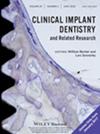Evaluation of Internal and External Hexagon Connections in Immediately Loaded Full-Arch Rehabilitations: A Multicenter Randomized Split-Mouth Controlled Trial With a 6-Year Follow-Up
Abstract
Background
Full-arch immediate loading rehabilitations are now a widely used rehabilitation method that guarantees predictable medium- and long-term results. Numerous factors can influence its success and stability in the medium and long term. Among these the implant-abutment connection seems to play an important role, however there is still little information on which is the most suitable in this type of treatment.
Purpose
The aim of the present multicenter split-mouth controlled trial is to evaluate whether external hexagonal connections (EHC) and internal hexagonal connections (IHC) can influence success, bone resorption and peri-implant parameters in immediate-load full-arch rehabilitations.
Materials and Methods
Twenty patients were rehabilitated with immediately loaded fixed full-arch rehabilitations. All the implants presented the same macro- and micro-topography but different implant-abutment connection. IHC were used in one randomly selected side of the jaw and EHC was used in the other side. Outcome measures were implant survival rate, peri-implant marginal bone loss (MBL), plaque index (PI), probing depth (PD), and bleeding on probing (BoP) evaluated at 3, 6, 12, 36, and 72-month post-loading. Technical and biological complications were recorded.
Results
In 20 patients, 43 EHC and 40 IHC implants were placed. Between 32 and 72 months of follow-up two patients withdrew (died) and no implants were lost. The cumulative survival rate (CSR) was 97.44% for EHC implants and 97.22% for IHC implants. The MBL presented a resorption of 2 mm in the EHC group and 1.9 mm in the IHC group. No statistically significant differences were found between the two groups for any of the parameters at any time. No biological or technical complications were detected between the 36th and 72nd month of follow-up.
Conclusions
After 72 months in function, both internal and external hexagon connections provided good clinical outcomes and were not associated with any significant difference in the clinical outcomes.


 求助内容:
求助内容: 应助结果提醒方式:
应助结果提醒方式:


